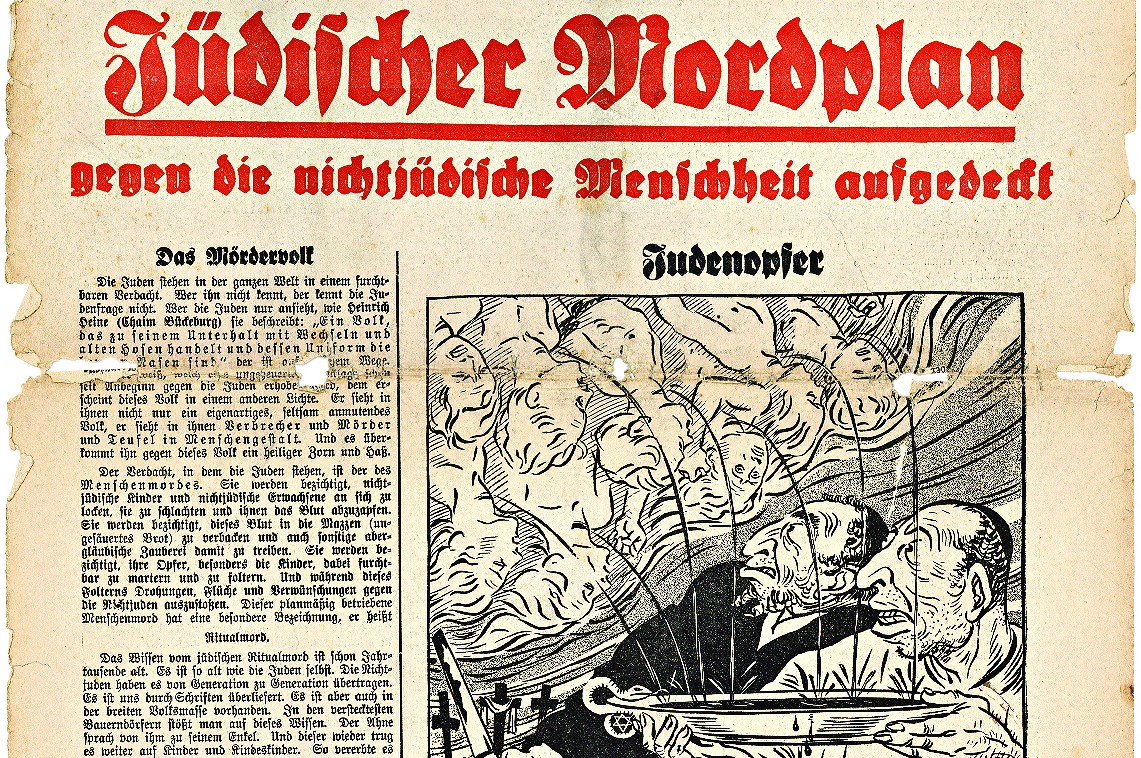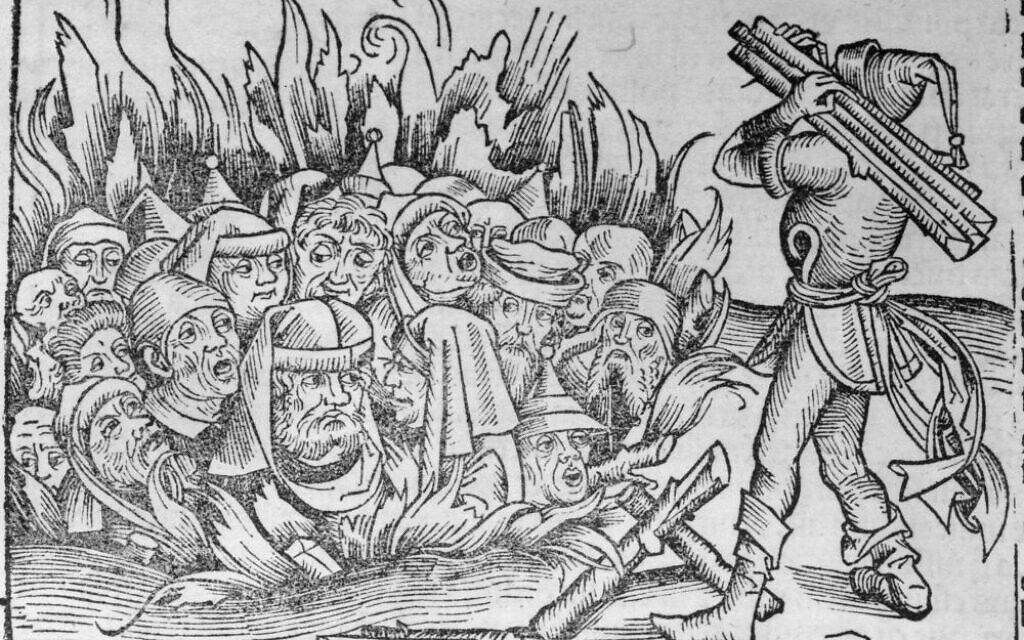Bloody Baby Photo of Arabic Child Is Fake
In 1475, a toddler named Simon was found dead in the town of Trento, Italy.
The boy's corpse was discovered on Easter Sunday in the cellar of a Jewish family's house. The Jewish leaders of Trento were immediately held responsible for the "ritual murder" of young Simon. All the Jews of the town were arrested, tortured, and forced to confess to the slaying.
The events in Trento were not the first time a Jewish community was held collectively responsible for the ritual murder of a Christian child. Back in 1144, in Norwich, England, a 12-year-old boy named William was similarly found dead. Years later, his murder was blamed on local Jews.
Although the events in Italy and England appear similar on the surface, something took place between the two incidents.
For three centuries, accounts of Jewish "ritual murders" had been confined to local lore and monastic chronicles. There was not widespread access to the tales, so the blood libel had little credibility with the public. Then, in the mid-fifteenth century, Gutenberg's printing press changed everything.
Get The Times of Israel's Daily Edition by email and never miss our top stories
By signing up, you agree to the terms
As books, broadsheets, and other printed materials proliferated on the continent, millions of people gained access to many forms of knowledge, including "factual" blood libel accounts. Simon of Trento became the first "poster boy" for the deadly canard and — more than 500 years later — there are still white supremacists involved in his cult.

Nazi-era 'Der Sturmer' Jewish ritual murder edition, May 1934 (public domain)
For her new book, "Blood Libel: On The Trail of an Antisemitic Myth," historian Magda Teter examined the blood libel from its roots in monastic tales to the pages of German Nazi broadsheets.
According to Teter, whose book was published on January 28, the blood libel developed a mutation when it crossed the sea from Britain to mainland Europe. Specifically, the element of Jews using Christian children's blood to make Passover matzah was added. As a matter of fact, goes the libel, the addition of human blood is ritually required to make matzah.

'Blood Libel,' by Magda Teter, 2020 (courtesy)
As with today's mass media movements, the blood libel had high-profile proponents. In this case, Prince-Bishop Johannes IV Hinderbach, an Austrian noble, let loose "a sophisticated multimedia propaganda campaign in the aftermath of the death of the toddler Simon in March 1475, exploiting the new print technology to disseminate the story far and wide," wrote Teter.
Using his own book and earlier legends as factual "proof," the powerful Hinderbach was able to persecute Jews with increased authority. He also lobbied Rome to canonize Simon.
According to Teter, Simon of Trento "became a near permanent fixture of Christian historical accounts, including authoritative lives of saints, capturing Christian imagination, even — as the manifesto by the shooter of the Poway synagogue, near San Diego in 2019 demonstrates — until our own times," wrote the historian.
"The myth of Jews killing Christian children persists in the European and now also, Middle Eastern imagination, although — thankfully — no longer in the courts," wrote Teter, chair of Jewish Studies at Fordham University in New York.
'Passovers of Blood'
In Teter's account of the blood libel's evolution, not all is doom and gloom. In particular, she lauds the ability of public statements and symbolism to push back against the libel.
An early Catholic leader who combated the blood libel was Cardinal Lorenzo Ganganelli, whose efforts bore fruit generations after his death, wrote Teter.

Historian and author Magda Teter (courtesy)
In 1759, the newly appointed cardinal created a secret report on the blood libel for the Holy Office of the Inquisition. Specifically, the Church was looking into blood allegations against Jewish communities in Poland.
After soliciting extensive information from Poland, Ganganelli wrote a fact-based report demonstrating the libel's falsity. He also defended the Jewish people at large, claiming they did not deserve to be branded with the libel as a group. The report was quietly accepted by leaders in Rome.
Ten years later, in 1769, Ganganelli himself became head of the Catholic Church as Pope Clement XIV. Although he removed Roman Jews from the Inquisition's legal jurisdiction, his report about the blood libel remained secret.
Investigators of the libel can have any number of motives, of course. While Cardinal Ganganelli was researching the accusations in Poland, false messiah Jacob Frank and his "Frankists" were pulling in another direction.
The Frankists — a heretical Jewish group — claimed there was truth to the blood libel. Specifically, they "charged that the Talmud, an ancient compendium of Jewish law and stories that had in fact been condemned to the flames by the Catholic Church, affirmed the need for Christian blood," wrote Teter.

Illustration showing Jews burning during the Inquisition (public domain)
To separate themselves from what they claimed to be normative Jewish practice, the Frankists said they did not accept the Talmud's authority. Therefore, the group did not require the blood of Christian children to make their matzah.
Centuries after the Frankists "exposed" Jews for ritually using Christian children's blood, Israeli professor Ariel Toaff made a similar claim with a twist.
In 2007, Toaff published "Passovers of Blood: The Jews of Europe and Ritual Murder," in which he hypothesized about the ritual use of small quantities of dried blood by Ashkenazi Jews during the medieval period. Although Toaff withdrew his book one week after publication, his "findings" spread far and wide.
Focusing on the Simon of Trento account in his final chapter, Toaff wrote that dried blood might have been used by "a group of fundamentalist Jews [who] did not respect the biblical prohibition [against use of blood]." Outraged critics said Toaff's book gave anti-Semites and white supremacists new fodder, and Teter agrees.

Bible made for French king with anti-Jewish illustrations, 1226-1234 (public domain)
"The Toaff affair reignited the belief in these stories, which I believe was waning, and undermined all the decades of efforts to discredit these stories, especially among Catholics in Catholic countries following the abolition of the cult of Simon of Trent," said Teter. "Though Toaff revised the book, the first edition of his book did long lasting damage that's still felt today."
'Public statements are key'
Prior to Teter's new book, there was never a comprehensive, continent-wide study of the blood libel's evolution in Europe. Although the deadly smear has been a European mainstay for centuries, there are challenges to probing the phenomenon, said Teter.
"We scholars are still very much trained in the 19th-century national-histories traditions: limiting our languages to nation-states," Teter told The Times of Israel. "So scholars of Italy or Germany, for example, would not be able to access east European sources, or deem them relevant; east European scholars may not consider German or Italian cases relevant to their local stories, etc."

In this file photo dated September 1945, pope Pius XII, wearing the ring of St. Peter, raises his right hand in a papal blessing at the Vatican. (AP Photo, File)
In addition to the borders-free nature of the blood libel, there are other academic hurdles to overcome, said Teter, including "the Jewish aspect and the additional required languages. We are also trained in specific periods. Thus blood libel has been studied as a 'medieval' accusation," said Teter.
Although the Catholic Church has come a long way in refuting the blood libel, the lethal lie remains a fixture of pockets in Europe. In England, for example, white supremacists still honor "sacrificial victims of the Jews." According to Teter, Catholic shrines tied to blood libels "persist unofficially" across Europe as magnets for Judeophobes.
In recent years, social media platforms have come under fire for hosting anti-Semitic content, including groups and pages about the blood libel. In 2014, the Anti-Defamation League demanded Facebook remove "Jewish Ritual Murder" pages.

A photograph taken following the Kishinev pogrom in 1903, when 49 Jews were murdered following a 'blood libel' against the Jewish community. Here, the victims are laid out wrapped in prayer shawls prior to burial (public domain)
"It's not just Facebook but also Google, the existence of those sites creates and reaffirms these 'epistemological communities' — these sites become sources of knowledge," Teter told The Times of Israel.
Facebook currently hosts content related to the blood libel, including links to a "Jewish Occult Murders" video with more than 1,000 views. On Amazon, too, there are products that present the blood libel as factual, including a self-dubbed "irrelevant defense" of "Jewish Ritual Murder," and Ariel Toaff's 2008 book, "Virtual Judaism," in which he responded to critics.
In Teter's opinion, flagging content as anti-Semitic "may not be a disincentive or warning for white supremacists." Perhaps, said the historian, identifying the content as "disturbingly false information" would be more helpful.
"Public labeling and public statements are key," said Teter.
Bloody Baby Photo of Arabic Child Is Fake
Source: https://www.timesofisrael.com/myth-of-jews-killing-christian-children-persists-says-new-book-on-blood-libel/
0 Response to "Bloody Baby Photo of Arabic Child Is Fake"
Post a Comment